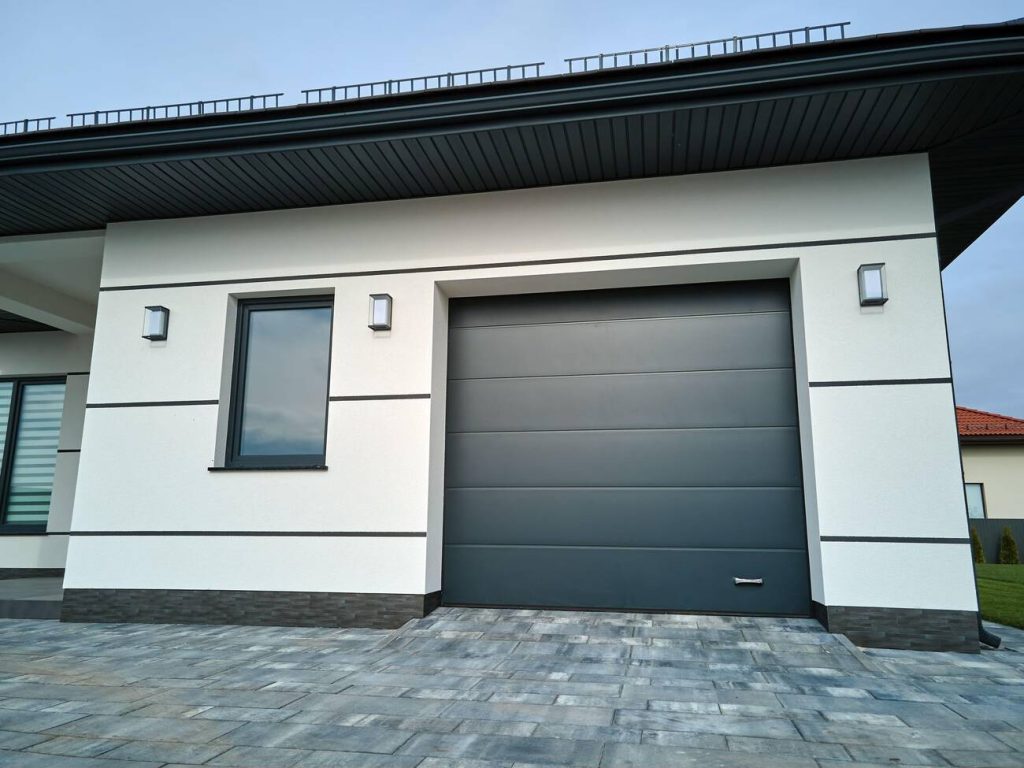You might be surprised to learn that even though they only operate for a few minutes each day, they actually consume quite a bit of energy in standby mode. But don’t worry, there are ways to improve their energy efficiency. By focusing on factors like insulation, U-factor, and R-value, you can ensure that your garage door is not wasting unnecessary power. In this article, we will explore the various factors that contribute to garage door energy consumption and provide tips on how to reduce it.
Energy Usage of Garage Doors
Garage doors use very little power while opening and closing, but they spend 3-5 times more electricity in standby mode. To reduce energy consumption and minimize the environmental impact, here are some energy-saving tips for garage doors. Firstly, consider installing energy efficient alternatives such as insulated garage doors. These doors provide better insulation, helping to regulate temperature and reduce energy loss. Secondly, opt for garage doors with power saving technologies, such as low U-factor and high R-value. These features ensure that the doors are resistant to temperature fluctuations and do not absorb heat from the rest of the home during colder months. Lastly, regular maintenance and properly fitted parts prevent air leaks, ensuring that cool air doesn’t escape in the summer and cold air doesn’t enter in the winter. These cost effective solutions can help save energy and reduce electricity usage in standby mode.
Factors Affecting Energy Efficiency
Insulation plays a crucial role in the energy efficiency of garage doors. By choosing the right insulation options, you can reduce energy loss and save on electricity costs. Smart home integration allows you to control your garage door’s energy usage remotely. When it comes to energy efficient materials, multi-layered garage doors with a high R-value and low U-factor are the best choice. These doors provide better insulation and prevent temperature fluctuations. To maintain energy efficiency, regular maintenance is essential. Ensure that all parts are properly fitted to prevent air leaks and energy loss. By considering these factors and following maintenance tips, you can reduce the environmental impact of your garage door while keeping your energy bills in check.
Importance of Good Insulation
To ensure energy efficiency in your home, it’s important to prioritize good insulation in your garage doors. The R-value of your garage door plays a crucial role in maintaining a comfortable temperature and reducing energy consumption. Higher R-values indicate better insulation, as they resist heat transfer and prevent air leaks. When selecting insulation materials for your garage doors, choose ones that have a high R-value and are environmentally friendly. Energy-efficient design, such as multi-layered doors, can also improve insulation. Good insulation not only helps in reducing energy costs but also has a positive environmental impact by reducing greenhouse gas emissions. By investing in proper insulation, you can enjoy a more comfortable living space while contributing to cost-saving measures and environmental sustainability.
Benefits of Multiple Layers in Garage Doors
Having multiple layers in your garage doors can significantly improve their insulation properties and help regulate temperature. Here are the benefits of multiple layers in garage doors:
- Improved Insulation: Multi-layered garage doors are naturally more insulative than single-layered doors. Adding an internal layer of polyurethane can make single-layered doors more insulative as well.
- Energy Saving Techniques: Multiple layers in garage doors contribute to better thermal efficiency, reducing the transfer of heat or cold air. This helps maintain a comfortable temperature inside your garage and can lead to energy savings.
- Thermal Efficiency: The added insulation from multiple layers prevents heat absorption from the rest of your home during colder months. It also helps resist temperature fluctuations, making your garage more comfortable year-round.
- Insulation Benefits: By providing better insulation, multiple layers in garage doors prevent air leaks and energy loss. This not only keeps cool air from escaping during summer but also prevents cold air from seeping in during winter. Overall, good insulation helps maintain energy efficiency and reduces the impact on your utility bills.
Preventing Air Leaks
Properly fitted parts prevent air leaks in garage doors, helping to maintain energy efficiency. One important aspect of preventing air leaks is the use of weatherstripping. Weatherstripping is a material that is placed along the edges of the garage door to create a seal and prevent air from escaping or entering the garage. It plays a crucial role in maintaining energy efficiency by preventing drafts and air leakage. Another factor that contributes to energy efficiency is proper insulation. Well-insulated garage doors help regulate temperature and prevent heat transfer, reducing the need for excessive heating or cooling. Choosing energy-efficient garage door materials, such as those with a low U-factor and high R-value, also plays a significant role in reducing energy consumption. Additionally, regular maintenance of garage doors ensures that all parts are properly fitted and functioning, further enhancing energy efficiency.
Garage Door Opener Power Consumption
Now that you understand the importance of preventing air leaks in your garage doors, let’s talk about another factor that affects your electricity usage: garage door opener power consumption. Here are some power saving tips and information on how to reduce electricity usage with your garage door opener:
- Choose energy efficient models: Look for garage door openers that are designed to be energy efficient. These models often have lower standby power consumption, which means they use less electricity when not in use.
- Consider standby power consumption: Some garage door openers consume a significant amount of electricity even when they are turned off. Look for models with low standby power consumption, such as those that use as little as 1 watt.
- Reduce usage when possible: If you don’t need to use your garage door opener, consider manually opening and closing the door to reduce power consumption.
- Use smart power strips and solar panels: Installing smart power strips can help reduce standby power consumption. Additionally, using solar panels can offset energy costs for operating your garage door opener.
Overview of Garage Door Openers
Garage door openers, invented by C.G. Johnson in 1926, gained popularity after World War II. Installing a garage door opener is a convenient way to automate the opening and closing of your garage door. To ensure smooth operation, it’s important to troubleshoot common issues that may arise. Regular maintenance is also crucial to keep your garage door opener functioning properly. Follow these maintenance tips to extend the lifespan of your opener. Additionally, prioritize garage door opener safety by regularly checking the safety sensors and ensuring they are properly aligned. Energy-saving features in garage door openers can help reduce power consumption. Look for models with low standby power consumption and consider using smart power strips or solar panels to offset energy costs.
How Garage Door Openers Work
The counterbalance system, using torsion springs, does most of the work in opening the garage door. Here is how garage door openers work:
- The garage door opener mechanism consists of an electric motor that turns an arm to move the door along a track.
- The trolley, powered by a chain or belt, propels the door forward or backward.
- In case of a power failure, the trolley arm can be disconnected for manual operation.
- Jackshaft garage door openers are a different type, as they are connected to the side of the door and are suitable for high ceilings.
To ensure the smooth functioning of your garage door opener, consider the following tips:
- Regularly troubleshoot and maintain your garage door opener to prevent any issues.
- Lubricate the moving parts of the opener to reduce friction and noise.
- Check the alignment of the photoelectric sensors to ensure they are working properly.
- When installing a garage door opener, follow the manufacturer’s instructions for proper installation.
Phantom Loads and Standby Energy Consumption
To minimize the standby energy consumption of your garage door opener, you can choose newer models with lower power usage. By opting for energy efficient garage doors, you can reduce standby power and save on standby energy costs. Good insulation plays a crucial role in enhancing energy efficiency. Look for garage doors with a low U-factor and a high R-value, as they prevent air leakage and improve insulation. Multi-layered garage doors provide better insulation and help regulate temperature. Preventing air leaks through properly fitted parts is also important. Regular maintenance and professional installation can prevent air leakage, keeping cool air from escaping during summer and cold air from entering during winter. By taking these steps, you can reduce the standby power consumption of your garage door opener and save on energy costs.
Reducing Garage Door Opener Power Consumption
By choosing newer, energy-efficient models, you can significantly decrease the power consumption of your garage door opener. Here are four ways to reduce energy costs and minimize standby power consumption:
- Use smart power strips: Smart power strips can detect when your garage door opener is not in use and automatically cut off power to prevent standby energy consumption.
- Consider solar panel installation: Installing solar panels can help offset the energy used by your garage door opener. By harnessing the power of the sun, you can reduce your reliance on traditional electricity sources.
- Consult a professional installer: If you’re not confident in installing a garage door opener yourself, it’s best to consult a professional. They can ensure proper installation and provide guidance on energy-efficient options.
- Be mindful of standby power consumption: When not in use, make sure to turn off your garage door opener completely. This will minimize standby power consumption and reduce your overall energy costs.
Impact of Garage Door Energy Consumption
Reducing the energy consumption of your garage door opener can have a significant impact on your overall electricity usage. By implementing cost-effective solutions and utilizing energy-saving technologies, you can reduce your environmental impact and save on energy costs. Consider the following table that compares the energy consumption of different garage door opener models:
| Garage Door Opener Model | Annual Energy Use (kWh) |
|---|---|
| Model A | 25.3 |
| Model B | 17.9 |
| Model C | 12.5 |
| Model D | 9.7 |
| Model E | 6.2 |
To further minimize your energy consumption, opt for sustainable garage door options with good insulation, low U-factor, and high R-value. These features will help regulate temperature and prevent air leaks, ensuring maximum energy efficiency. Additionally, consider installing solar panels and using smart power strips to offset energy costs. Consulting a professional installer can also provide guidance on selecting the most energy-efficient garage door opener for your needs.
Conclusion: Making Informed Decisions About Garage Door Energy Usage
When making decisions about energy usage for your garage door opener, it’s important to consider factors such as insulation, power consumption, and the overall impact on your electricity usage. To ensure energy efficiency and reduce electricity costs, here are some key strategies to consider:
- Cost-effective insulation: Invest in a garage door with good insulation, such as one with a low U-factor and a high R-value. Multi-layered doors provide better insulation and help regulate temperature.
- Professional installation benefits: Seek the expertise of a professional installer to ensure proper fitting of parts and prevent air leaks. This will help maintain energy efficiency and prevent energy loss.
- Smart power usage: Opt for newer models of garage door openers that have reduced standby power consumption. Consider using smart power strips and installing solar panels to offset energy costs.
- Environmental impact: By implementing energy-saving strategies, you can reduce your carbon footprint and contribute to a more sustainable environment.





